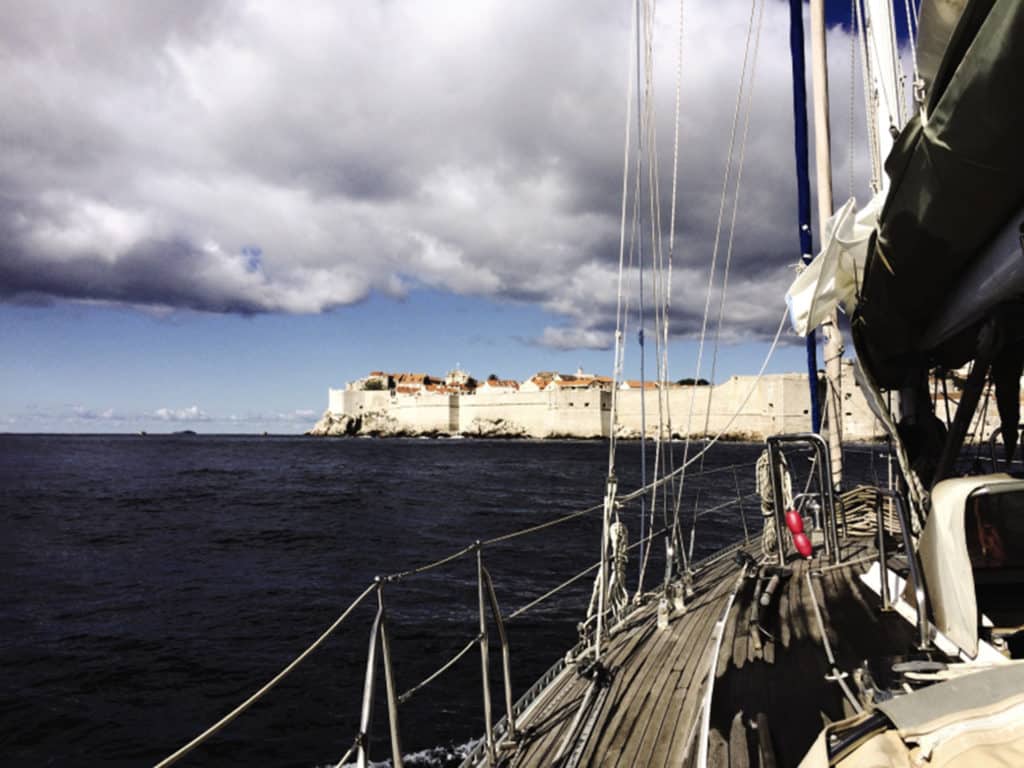
Over the past six years, Scarlet, our 47-foot Warwick cruiser/racer from the mid-’80s, sailed east with a rotating crew from Martinique to the Mediterranean. During that time, Scarlet’s longtime owner, Spencer Smith, and I visited Portugal, Morocco, Spain, France and Italy, which left us wondering, what’s next? Do we turn around now? Had we reached the end of the popular part of the Med?
If we had turned around before we reached the Dalmatian coast, we would have missed what we now consider the best cruising ground in the entire Med. If you want islands, warm water, protected bays with snug harbors, modern marinas, and unfamiliar—even exotic—towns and cities steeped in ancient history, well, Croatia is the place. Small, ancient harbors are everywhere. They have sheltered sailors since earliest maritime history, and here they are, still sheltering cruising sailboats.
And, if you’re like Scarlet’s crew and sail with one eye on the GPS and one eye in a book about the history of your sailing grounds, you’ll be a happy sailor in Croatia.
Croatia’s shoreline forms the long, eastern coast of the Adriatic Sea (along with Montenegro and Albania). The Dalmatian islands lie close to the mainland, and are parallel to the east coast of Italy. The area has a long and complicated history, starting with the legendary Greek tales of Odysseus and Calypso, the oared warships of the Illyrians, the ancient maritime culture of the Roman and Venetian occupations, Ottoman pirates, tribal wars, Nazi occupation and then Soviet domination of Yugoslavia. Followed, of course, by the punishing civil war of the 1990s. Croatians are enjoying peace now, and have optimism for the future and pride in their beautiful landscapes, making it a rich and joyful cruising ground. There are islands galore: large ones with cities and medieval towns to explore, and small agricultural ones still inhabited by sheep, donkeys and, happily, the occasional small waterfront restaurant. The best way to see this maritime nation, with the spectacular mountains as a backdrop and wild islands to explore, is from the deck of a sailboat.
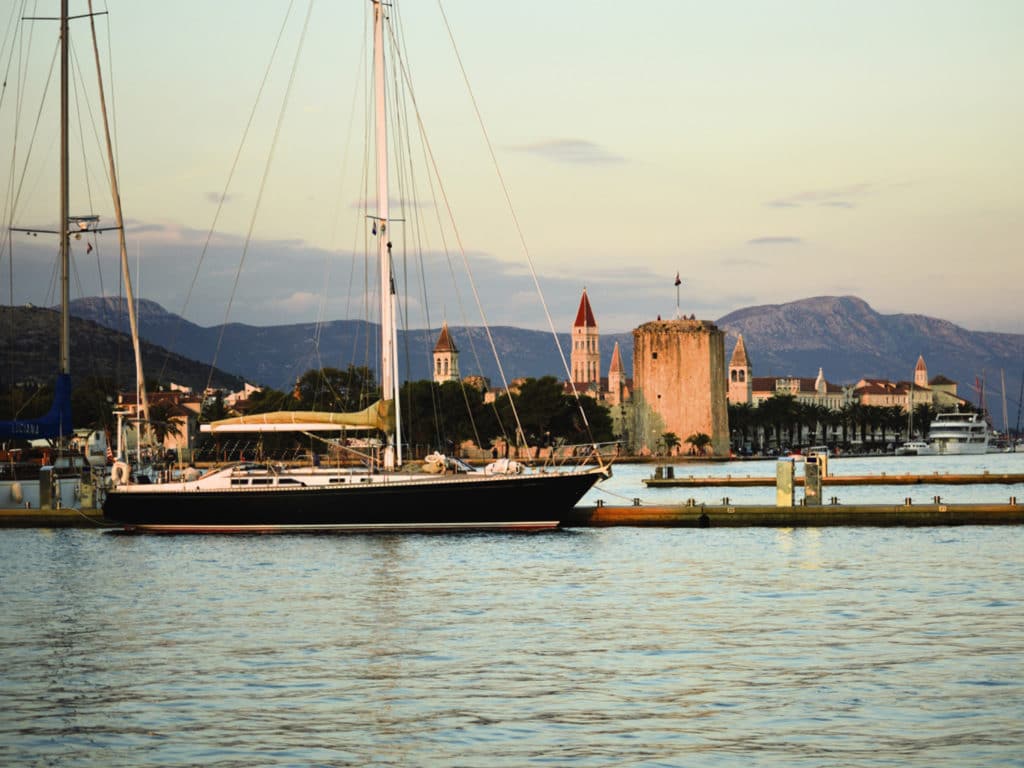
History, Culture and Anchorages Galore
Superb destination cities such as Krk, Split/Trogir, lavish Hvar, and Marco Polo’s birthplace, Korcula, were built to trade by sea, providing a profitable sea lane between Venice and the East. Beset by centuries of marauding pirates and warlike neighbors—right up to the tragic wars of the 1990s—the cities present a fortified face to the sea. Within Croatia’s walled cities, there are cultural sites such as Venetian palaces, Benedictine monasteries, Ottoman mosques and, perhaps the most famous, the Emperor Diocletian’s elegant palace in Split. But the fortress walls are easy to penetrate now, and a sailor ashore has a fine choice of activities and culture to be discovered. The Austrian/Nazi submarine pens carved into the cliff faces are empty now, ripe for exploration by dinghy. Or you could lay your dock lines to a massive marble Roman quay on the sleepy island of Silba, where oared warships tied their lines a thousand years ago, seeking the protection of the same natural harbor.
All along the coast of Croatia you’ll find protected anchorages suitable for private boats, and others large enough for the busy fleets of chartered sailboats. The welcoming protective headlands provide a fresh choice of destinations every day, and even a selection of stops for lunch. In the lee of steep-sided islands, there are so many suitable anchorages that we stopped needing the advice in the otherwise excellent guidebooks—whenever we felt we needed relief from a headwind or sudden bora (the north to northeastern katabatic winds), we could find an anchorage near at hand. For example, we dropped the hook in the lee of the small island of Zut, where we walked to a delightful and good- natured restaurant on a hillside above the harbor. Another time we discovered a private swimming beach at the south end of Otok Lopud. Walking up the road from the wharf in Zlarin, we stopped to watch a family harvest green olives, and next to the ubiquitous olive groves, there was a perfect chapel, where votive bouquets were carefully arranged around the windows.
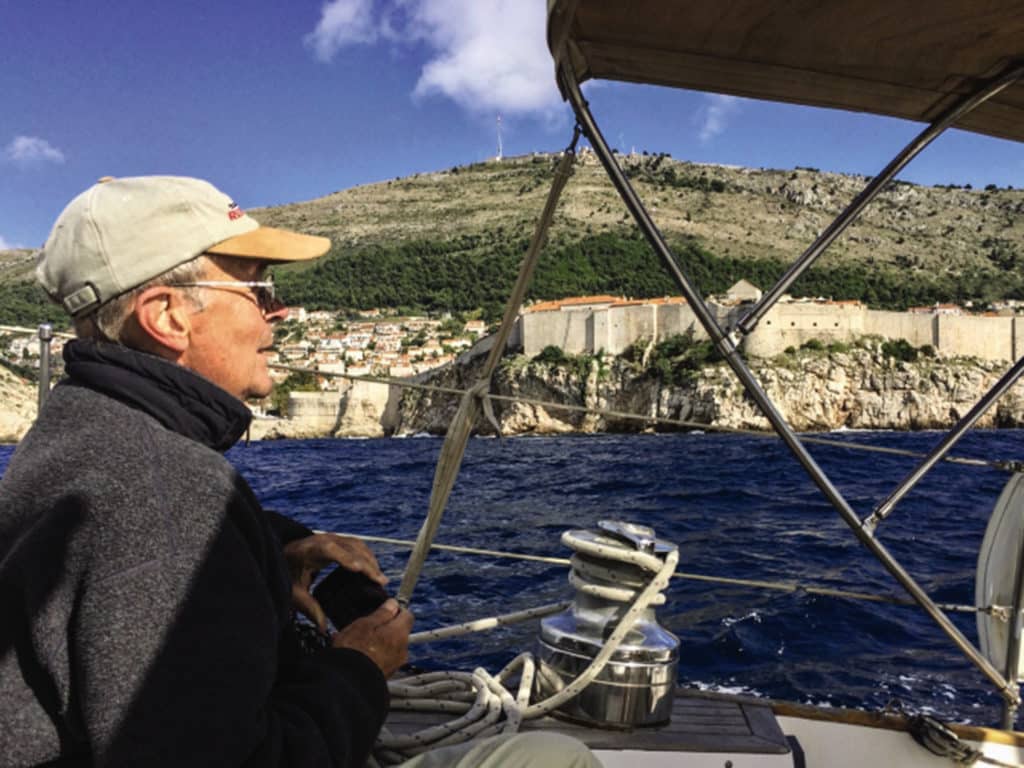
Whenever we needed some culture, we could steer a course for a port city. Hvar, Split (and its close neighbor Trogir), Murter and Krk to the north, are our favorite ports, steeped in beauty as well as history at the base of 3,000- to 9,000-foot rock-faced mountains. Each of these ports offers splendid waterfront establishments, hotels, Airbnbs, taxis and airport connections, plus a full menu of services for the fleets of sailboats sweeping in through the hot days of summer.
Every few days, Spencer and I found that we liked to restock at the farmers markets, often located near the waterfront, or visit one of the modern marina establishments near the bigger cities. The whole coast is studded with welcoming marinas, designed to get sailors out racing, out to the islands, or on to the next port city. Croatia is the home of the largest sailboat charter fleet in the world, with about 4,000 boats, and Adriatic Croatia International is a well-organized chain of 22 marinas along the Croatian coast that are often located right near the most popular harbors and charter centers. These marinas consistently offered well-protected slips, knowledgeable repair staff, and good water and fuel. And they were usually located within walking distance from the restaurants and major museums in town.
We were beyond thrilled to set the anchor outside an intact roman sea gate—which to us looked like it could have been part of a movie set.
When cruising Croatia, be prepared to tie up Med-style, with the boat’s stern-to a stone quay and another vessel snugged right alongside. For the skippers who can steer in reverse gear at high speed and have use of a joystick and bow thruster to straighten out their craft, this looks easy. For the rest of us, with no joystick or bow thruster on the boat and little confidence in how it might steer in hard reverse, well, we just take it slow. The dockhands jump up when they see us approach, and with strong helping hands, take our lines and pass us the long underwater laid lines, which are secured to anchored chains far out in the channel. With many, many fenders, it can be done without mishap. We had better luck nosing in bow-first to the wharf, which protects the Monitor windvane hanging off the stern, and then climbing over the bow pulpit and the anchor roller to the wharf. This also makes the cockpit a little more private while on a busy waterfront, particularly in a popular town like Hvar, where crowds of tourists pass along the polished sidewalks and gaze at the boats.
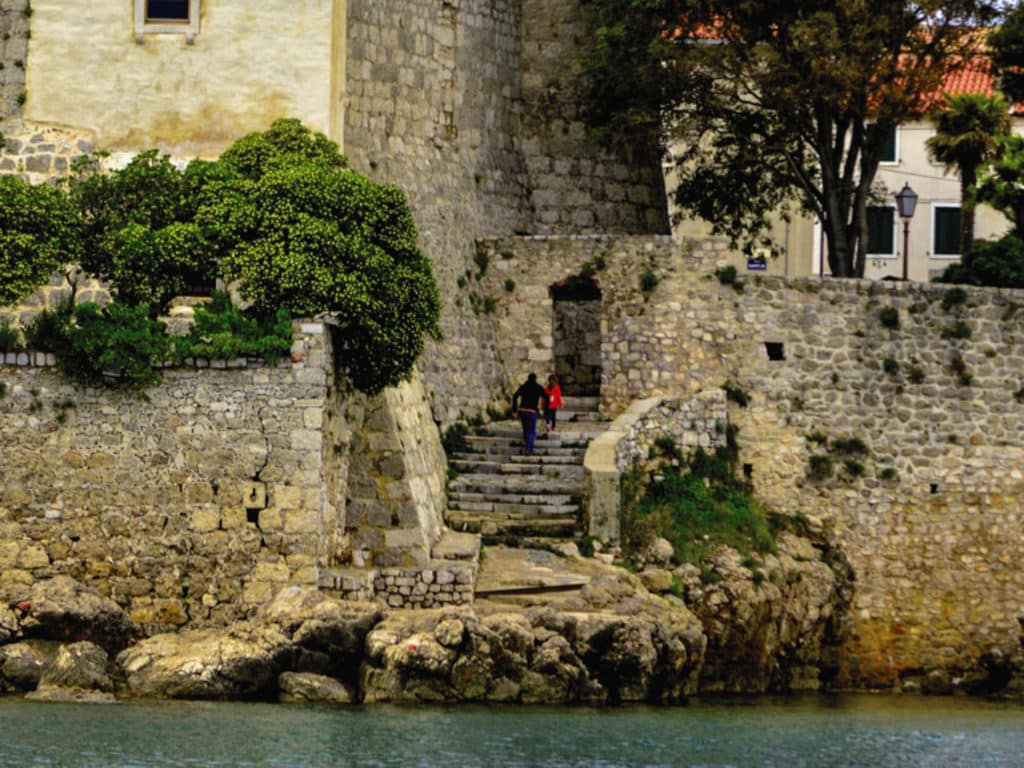
Our Favorite Places
On the southeastern end of the long, narrow Dugi Otok, (otok means “island,” dugi means “long”), which some consider the most beautiful of the Kornati Islands, lies Telascica Nature Park. Two friendly park wardens, who manage the property and extensive anchorage, came by in a small boat and collected a fee, charged per boat; in our case, the fee was 380 Croatian kunas, or about $42, which we were happy to pay in view of the pristine preserve. Although well-protected, this beautiful bay can get crowded with boats anchored in the sailing season. The inner harbor of Luka Telascica has a perfect anchorage 4 miles up the bay, where we were the only boat in our quiet cove. The next morning, we were awakened by donkeys, braying gently as they wandered the steep slopes.
On the rough shoreline of Luka Telascica, the sharp rocks are made of karst, a carbonate rock that characterizes the Croatian coast. Karst is a porous limestone that dissolves over time in flowing water, leaving caves, sinkholes and bonelike surfaces, scoured by the water moving through it. From a small dock, we picked our way across the sharp rocky beach and hiked up to the radio tower at the top of Dugi Otok. There we were surprised to find ourselves on the edge of an unprotected cliff edge, with a shocking 150-meter sheer drop-off into the water and a spectacular view across the aqua blue Adriatic Sea toward Italy.
The next day, on the eastern side of Dugi Otok, in the protected harbor of the town of Luka, we anchored for the day and watched a young woman and her grandfather head out on a small fishing boat; they returned in the afternoon with her catch.
That evening, when we asked the proprietress of the restaurant if they were open for dinner, she said it was their first day of the season and they had one “tooth fish” that she had caught with her grandfather that day. In honor of their opening, we had a free drink and the grilled tooth fish. Her grandfather, the same fisherman we had seen earlier in the day, sat at a table with some friends, and then we all watched the sun set over the harbor and the fishing boat, with Scarlet anchored nearby. That is offseason cruising in Croatia!
The Kornati Archipelago is a chain of water-washed cones of karst. The remarkable white pyramid-shaped moonscapes rise from the deep water of the Adriatic Sea. These white mountains, stunning and wild, are beautiful to see up close from the deck of a boat as the light changes along their smooth angled slopes. Sailing between the islands in Kornati National Park feels like a peaceful cruise on the moon, with spectacular anchorages close by.
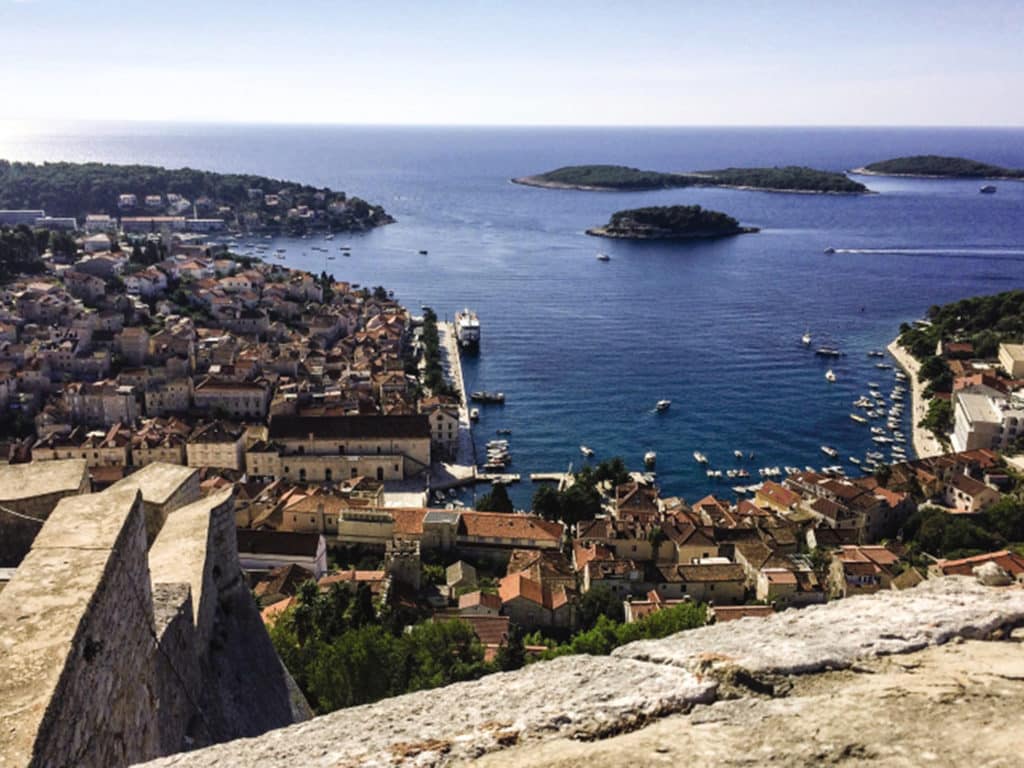
The enchanting, southernmost island of Mljet turned out to be our favorite stop. We entered a narrow opening into the long undeveloped bay to the small town of Polace. As we approached, I thought to myself: What is that high smokestack? An industrial ruin? Nope—it was a ruined palace! The walls of a Roman castle, built in the third or fourth century for the Roman Agesilaus and his poet son, tower above the small town. From the main pedestrian lane in the village, you can walk right up to the Roman walls, stare up at the stonework and marvel at the passage of history.
Most of Mljet is still wooded and green—a national park—laid out with manicured hiking trails, a lake and a picture-perfect island monastery. The modest park fee of 250 kunas (less than $40) covers three days of anchoring and hiking.
Some think Mljet may have been the home of the mythical nymph Calypso, who loved and entrapped the wandering sailor Odysseus, and held him captive in one of the caves on the island. After seven years, the immortal nymph was convinced by the goddess Athena to build Odysseus a boat and let him continue his journey homeward, according to Homer in The Odyssey. There is a nice seafood restaurant there named for her—the Calypso—where we sampled the local dish “Octopus Under the Bell.”
We found our own paradise, tied bow-in toward the Calypso’s terrace in Polace, and the stern anchored out on the long mooring lines provided.
Otok Krk is a large, settled island in the north end of the Adriatic, close to the Istria peninsula and Trieste, Italy, and it reflects the influence of the Venetian empire. The ancient town of Krk has a strong sense of history, marked by the obvious ruins of the Roman town of Curicum, where in 49 B.C., Caesar and Pompey fought a great sea battle. We were beyond thrilled to set the anchor outside an intact Roman sea gate—which to us looked like it could have been part of a movie set—where goods were traded through the fortress walls of Krk for the past millennia. We walked through the town and could see Scarlet at anchor, framed by the stone arch of the sea gate.
After a few years of seasonal cruising and visiting countries of the Adriatic Sea, we sailed Scarlet south into Greek waters. But for varied, well-protected harbors of sophistication and deep maritime history, Croatia remains dear to our hearts, and we are planning a return visit. There is a lot more to see there, and it is best seen from the deck of a sailboat.
Queene Hooper Foster sails her Concordia yawl in Maine these days, when not sailing for several months of the year on Scarlet, based in the eastern Mediterranean.
Chartering in Croatia
There is no doubt that Croatia offers a spectacular cruising ground, and that there is an abundant charter fleet available for visiting sailors. But there are a few hoops that American sailors will need to jump through before being allowed to charter a boat.
Croatia, like other European countries, requires bareboat-charter captains to produce internationally accepted paperwork demonstrating competency in handling recreational vessels.
What that means for Americans is that an experiential sailing resume and a US Coast Guard-issued captain’s license are of course helpful—yet incomplete—if you’ve set your sights on taking family and friends on a cruise along the Dalmatian coast.
The requirement dates back to the adoption of United Nations Resolution 40, a recreational boating safety initiative proposed by countries seeking to reduce accidents on the water and the corresponding strain on emergency services. The International Certificate of Competence required of sailors is laid out in detail as part of UN 40.
Because the United States isn’t a signatory of UN 40, alternatives recognized by the Croatian government and charter companies include the International Proficiency Certificate.
US Sailing and the American Sailing Association, as well as their extensive network of affiliate schools, offer the IPC as a viable path for Americans to charter abroad. NauticEd, an online-based sailing school, offers the Sailing License and Credentials course, which is also accepted by the Croatian government and charter companies. Other options include obtaining the ICC qualification itself through the Royal Yachting Association of the United Kingdom.
“Countries and charter companies have been accepting the IPC because it so closely aligns with the ICC,” says Rich Jepsen, vice president of the board of directors of US Sailing, the governing body of the sport. “It is the ICC in spirit, if not rule.”
Jepsen, whose background includes decades of certifying sailors with ASA and with US Sailing, is an advocate of certification and related requirements that keep vacationing sailors’ skills sharp in foreign waters.
While the cost of the IPC is nominal, it tests on-water practical proficiency and theoretical knowledge with regard to multiple nautical standards. For US Sailing members, the IPC is an extension of the organization’s Keelboat Certification System, which includes completion of the US Sailing Bareboat Cruising course. Experienced sailors can challenge the required prerequisite levels by successfully completing written and practical examinations.
ASA’s certification is similarly prerequisite-based. Member sailors qualified for the IPC are those who have successfully completed ASA basic and bareboat cruising courses 101, 103 and 104. Experienced sailors who want to challenge the course content and gain IPC certification must pass written tests and on-the-water skills assessments.
“Many excellent sailors fail the ASA written and on-the-water tests,” says Elbert “Ash” Ashbaugh III, an ASA affiliate instructor. “A prudent plan would be to study/review the appropriate ASA textbooks and self-analyze your skills before challenging the courses.” Another practical option for experienced sailors who haven’t taken any basic courses, Ashbaugh advises, is to take the 104-level course and arrange to also be tested for the 101 and 103 prerequisite courses.
The IPC issued by ASA and US Sailing is valid for five years from date of issue.
“The IPC is the cheapest and most dependable way to comply with the rules and get to see these sailing wonders,” Jepsen says. “Think of the expense and uncertainty of the average US sailor who wants to charter in Greece or Italy or Croatia. They will have to expand their vacation to include testing at an approved European facility, pay for and perform that test, and hope they pass so they can actually take their $10,000 charter they’ve had reserved for a year. The IPC isn’t perfect, but it’s a brilliant workaround to a large bureaucracy.”
Charter companies operating in Croatia include:
Adriatic Weather
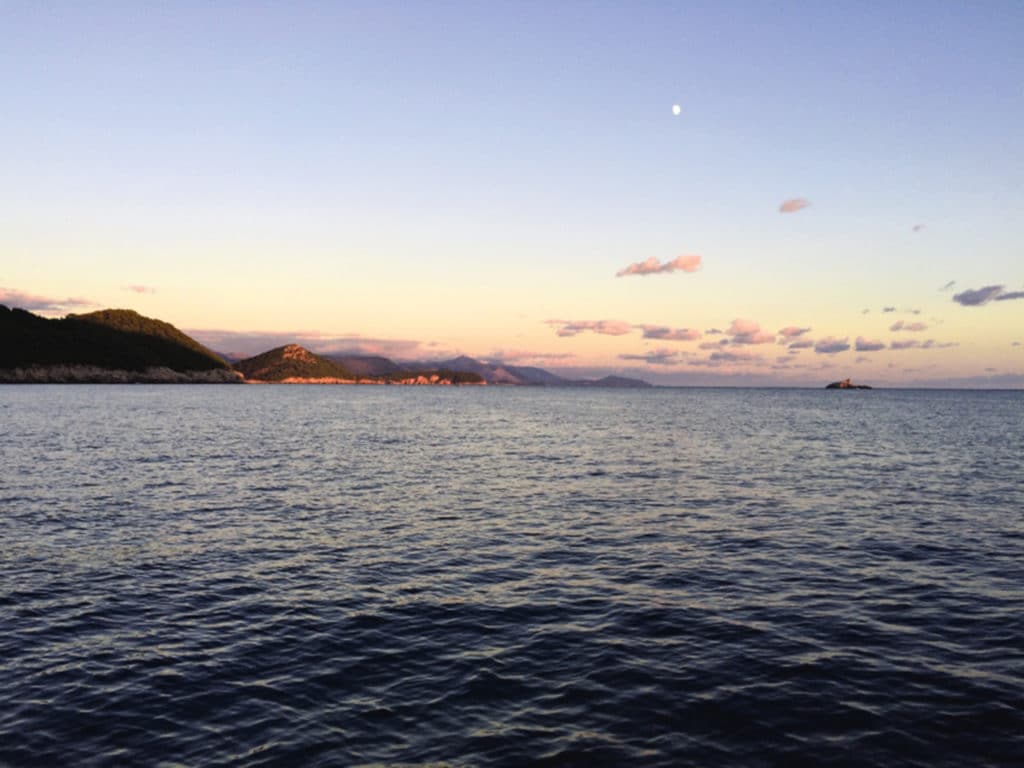
The high season in Croatia is June, July and August, and features mostly easy sailing weather. Light to moderate breezes from the north or south predominate, and they rise in the late morning and decline with the sun. The steep mountains that line the shore of Croatia, however, and the narrow “kanals” between the mainland and islands—and between islands themselves—can cause local weather anomalies that will have you scrambling to shorten sail. If you see a bank of clouds resembling a beard over the mountaintops, particularly the Velebit mountains north and east of Split, be prepared to reef down and find a lee under a nearby island.
In the shoulder seasons of April/May and September/October, the weather might be challenging. The bora can bring high barometric pressure, clear weather and severe winds off the mountains. It might blow steadily for a day—or for three days. The bora’s warm southerly counterpart, the low-pressure jugo, arrives with squalls, rain, thunder and high drama. It also can blow for a couple of days.
Both of these weather systems are predictable, however. Marinas post the weather daily and internet weather sites are useful, but there might not be enough detail to show the local changes. You have to diligently watch the cloud formations over the mountain summits.
We were expecting a strong bora in October—the late sailing season—and from the 5,000-foot mountains to the north and east, the strong winds came. Every morning we would watch for the gray beards, great swirling cumulous clouds, hovering over the rocky summits of the mile-high Velebit mountains. Within a day, the katabatic winds off those slopes would be howling down the narrow Velebit Kanal, at a steady 40 knots. To us it seemed odd that high pressure and bright sunshine often accompanied these strong winds.
Weather info is easy to get in Croatia and Montenegro. Excellent cellular service and Wi-Fi are readily available in marinas and restaurants, and maritime weather forecasts like those available on the Croatian Meteorological and Hydrological Service’s website (meteo.hr) are easy to access, in the local language and in English. Most marinas post forecasts at their office. VHF weather is available, though the schedule can be hard to track. Be wary of nonmarine forecasts, which regularly underestimate the local wind strength.
Valuable Guides and Charts
Adriatic Pilot: Croatia Slovenia, Montenegro, East Coast of Italy and Albania, Eighth Edition By Trevor and Dinah Thompson 2020; Imray Laurie & Wilson Ltd.
The Adlard Coles Book of Mediterranean Cruising, Fourth Edition By Rod Heikell 2018; Adlard Coles Nautical
Imray Chart M23 Adriatic Sea Passage
Imray Chart M24 Trieste to Losinj and Rab
Imray Chart M25 Otok Rab to Sibenik
Imray Chart M26 Split to Dubrovnik








